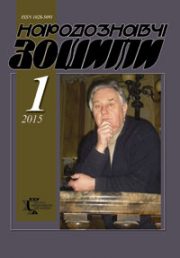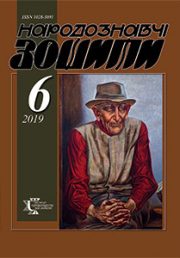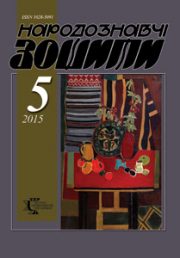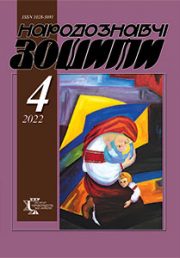The Ethnology Notebooks. 2018, 3 (141), 656–661
UDK 94(477.83-25):[641.3:339.562(=14=19)]”14/17″(083.72)
DOI https://doi.org/10.15407/nz2018.03.656
EAST MEDITERRANEAN PRODUCTS ON THE TABLE OF LVIV BURGHERS IN THE XV—XVII c.
Lylo Ihor Mykolaiovych, doctoral student
of Ivan Franko National University of Lviv,
associate professor, candidate of sciences in history.
Universytetska Street 1, 79000, Lviv, Ukraine.
Contacts: Grunwald Street 12/12, Lviv, 79044, phone 0636150793, e-mail lylolv@yahoo.com
Abstrakt. Gastronomic preferences of the citisens of Lviv in the historical retrospective are an interesting testimony to the daily life of the community. Morever a researcher can to feel the «taste» of spirit of the epoch. Sources testify to the financial capacity of the townspeople, their aesthetic preferences the knowlege of the outside world. Food is a remained factor that united people regardless of their ethnic origin or political affiliation. Food products of the Mediterranean were popular in Lviv in 16 and 17 c.
Keywords: Mediterranean, Greeks, Armenians, malvasia, pepper, Lviv.
Received 01.03.2018
References
TsDIA Ukrainy u m. Lvovi, f. 52, op. 2, spr. 21. Knyha zapysu induktiv i protokoliv uriadu rady (1589—1590) [in Ukrainian].
TsDIA Ukrainy u m. Lvovi, f. 52, op. 2, spr. 240. Indukty spirnykh sprav (1539—1561) [in Ukrainian].
TsDIA Ukrainy u m. Lvovi, f. 52, op. 2, spr. 243. Indukty spirnykh sprav (1569—1576) [in Ukrainian].
TsDIA Ukrainy u m. Lvovi, f. 52, op. 2, spr. 245. Knyha zapysu induktiv i protokoliv spirnykh i kryminalnykh sprav lavnychoho sudu (1579—1582) [in Ukrainian].
TsDIA Ukrainy u m. Lvov, f. 52, op. 2, spr. 247. Knyha zapysu induktiv i protokoliv spirnykh i kryminalnykh sprav lavnychoho sudu (1585—1587) [in Ukrainian].
TsDIA Ukrainy u m. Lvovi, f. 131, op. 1, spr. 488. Kolektsiia hramot na perhamenti. Hramota polskoho korolia Syhizmunda II pro poriadok torhivli u misti Lvovi vynamy, pryvezenymy z Hretsii [in Ukrainian].
Vasylieva, O. (2013). Formuvannia tradytsiï prydvornoho benketu v Hetmanshchyni (druha polovyna XVII — persha tretyna XVIII st.). Povsiakdennia rannomodernoi Ukrainy. 1, 57—68. Kyiv: Instytut istorii Ukrainy NAN Ukrainy [in Ukrainian].
Zamostianyk, I. (2004). Protokoly sudovoho protsesu lvivskoho stoliara Yana Havlovycha yak dzherelo do vyvchennia materialnoï ta zvychaievoï kultury pochatku XVII st. Drohobytskyy̆ kraieznavchyy̆ zbirnyk. Issue. 8, 430—444 [in Ukrainian].
Zamostianyk, I. (2016). Cholovichyi odiah lvivskykh mishchan kintsia XVI — pershoi polovyny XVII st. Narodoznavchi zoshyty, 4 (130), 873—883 [in Ukrainian].
Zaiats, O. (2016). Zvychai ta povsiakdenni praktyky lvivskoho tsekhu bahatykh kramiv u svitli protokoliv XVI — pershoi tretyny XVII st. Istoriia torhivli, podatkiv ta myta, 1—2 (13—14), 79—104 [in Ukrainian].
Zvarych, V., Shust, R. Numizmatyka. Dovidnyk. Ternopil; Lviv: Ternopil; Lvivskyi derzhavnyi universytet im. Ivana Franka [in Ukrainian].
Zubrytskyi, D. (2002). Khronika mista Lvova. Lviv [in Ukrainian].
Istoricheskie svjazi narodov SSSR i Rumynii v XV — nachale XVIII v.: Dokumenty i materialy: v treh tomah. (1965). Moskva [in Russisn].
Kapral, M. (2012). Liudy korporatsii: Lvivskyi shevskyi tsekhu XVII—XVIII st.. Lviv: Lvivske viddilennia IUAD im. M.S. Hrushevskoho NAN Ukrainy [in Ukrainian].
Kryvonos, V. (1998). Do pytannia pro diialnist seredzemnomorskykh hrekiv u Lvovi v XVI — seredyni XVII st. In Lwów: miasto, spoleczeństwo, kultura. (Vol. II, pp. 59—67). Kraków [in Ukrainian].
Lenchenko, V. (2006). Rezydentsiia hetmana Ivana Mazepy v Baturyni. Materialy mizhn. nauk.-prakt. konf. z nahody 295-yi richnytsi z dnia smerti hetmana Ukrainy Ivana Mazepy ta 10-richchia zasnuvannia zapovidnyka «Hetmanska stolytsia». (pp. 120—126). Nizhyn [in Ukrainian].
Lylo, I.M. (2015). Do pytannia pro shchodenne zhyttia lvivskykh mishchan XVI st. za inventarem osobystykh rechei Sofii Afendyk. Visnyk Lvivskoho universytetu. Seriia istorychna. Issue 51, 632—645 [in Ukrainian].
Perelyhina, O. (2010). Korniakta Kamianytsia. In Entsyklopediia Lvova. (Vol. 3, 411—415). Lviv [in Ukrainian].
Petryshak, B. (2011). «Lytsar pera i kalamaria» — pysar mista Lvova Voitsekh Zymnytskyi (1583—1639 rr.). Issue. 3. Lviv [in Ukrainian].
Podgradskaja, E.M. (1991). Jekonomicheskie svjazi Moldavii so stranami Central’noj i Vostochnoj Evropy v XVI—XVII vv. Kishinjov: Shtinica [in Russisn].
Hroniki: Litovskaja i Zhmojtskaja, Byhovca. Letopisi: Barkulabovskaja, Averki i Pancyrnogo. (1975). In Polnoe sobranie russkih letopisej. (Vol. 32). Moskva: Nauka [in Russisn].
Kapral, M. (ed.). (1998). Pryvilei mista Lvova (XIV—XVIII st.). (Vol. 1). Lviv [in Ukrainian].
Andrews, K. (2006). Castel of the Morea. Athens [in English].
Bystroń, J. (1933). Dzieje obyczajów w dawnej Polsce: wiek XVI—XVIII. (Vol. 1). Warszawa: Trzaska, Evert i Michalski [in Polish].
Dias-Lewandowska, D. (2015). Wine and identity in Poland from thelate seventeenth to the early nineteenth century.In Biographies of Drink: a Case Study Approach to Our Historical Relationship with Alcohol. (pp. 138—157). Cambridge Scholars Publishing [in Polish].
Dumanowski Andrzej. (2012). Poznański Sekrety kuchmistrzowskie Stanisława Czernieckiego. Warszawa; Księga szafarska dworu Jana III Sobieskiego 1695—1696. (2013); Monumenta Poloniae Culinaria. (Vol. IV). Warszawa [in Polish].
Dziubiński, A. (1998). Na szlakach Orientu. Handel między Polską a Imperium Osmańskim w XVI—XVIII w. Wrocław: Leopoldinum [in Polish].
Hryszko, R. (2000). Obraz Kilii — kolonii genueńskiej nad Dunajem, w świetle akt notarialnych Antonia di Ponzo z lat 1360—1361. Zeszyty Naukowe Uniwersytetu Jagiellońskiego, 12 [in Polish].
Haris, Kalligas. Monemvasia. Seven-Fifteenth Centuries. The Economic History of Byzantium: From Seven througt the Fifteen Century Dumbarton Oaks Research Library and Collection, 39, 879—897. Washington: D. C. [in Polish].
Trojanowska, Maria (ed. oprac). (1998). Katalog Dokumentów rуznej proweniencji Miast, wsi, cechów, parafii, klasztorów a osób prywatnych 1397—1794. Lublin [in Polish].
Kuchowicz, Z. (1993). Obyczaje i postacie Polski szlacheckiej XVI—XVIII wieku. Warszawa [in Polish].
Łoziński, W. (1902). Patrycyat i miesczaństwo lwowskie w XVI—XVII wieku. Lwów: Księgarnia H. Altenberga [in Polish].
Nadel-Golobič, E. (1979). Armenians and Jews in Medieval Lvov: Their role in Orient trade. Cahiers de Monde russe et sovietiqe. Volum. XX. Nos. 3—4. Pp. 345—388. Paris; Hague; New York [in Polish].
Rybarski, S. (1928). Rozwój handlu i polityki handlowej. In Handel i polityka handlowa Polski w XVI stuleciu. (Vol. 1). Poznań: Nakładem Towarzystwa Miłośników Miasta Poznania [in Polish].
Savary des Bruslons. Dictionnaire de commerce. (Vol. 4, 1049; Vol. 5, 582) [in Polish].
Tentiuc, J. (1997). Some Considerations Regarding Byzantine Influences in the East of Carpathians in the 10th—13th Centuries. Medieval Europe Brugge International congres over Middeleeuwse en Latere Archeologie. (1—4 October). Brugge [in Polish].
Thomas, S., Noonan & Roman, Kovalev. (1999). Wine and Oil For All the Ru’s! The importantion of Byzantine wine and olive oil to Kievan Rus’. Byzantium and the North. Acta Byzantina Fennica. V.IX.1997—1988. (pp. 118—152 ). Helsinki [in Polish].
Scott, C. (ed.). (2014). The SAGE Encyclopedia of Alcohol: Social, Cultural and Historical Perspectives. Martin [in Polish].
Volumina Legum. Przedruk Zbioru Praw Staraniem XX Pijarow w Warszawie, od roku 1732 do roku 1782 wydanego. Petersburg: Nakładem i drukiem Jozafata Ohryzki [in Polish].
Wyczański, A. (1969). Studia nad konsumpcją żywności w Polsce w XVI i pierwszej połowie XVII w. Warszawa [in Polish].
Żakiej Tadeusz. (1986). W staropolskiej kuchni i przy polskim stole. Warszawa [in Polish].
Zubyk, R. (1930). Gospodarka finansowa miasta Lwowa 1624—1635. Lwów [in Polish].
Protasevich, V.I. (1962). Pamjatniki politicheskoj satiry XVII v. «Rech’ Ivana Meleshki» i «Pis’mo k Obuhovichu». In Iz istorii filosofskoj i obshhestvenno-politicheskoj mysli Belorussii. Izbrannye proizvedenija XVI — nach. XІX v. Retrieved from: http://starbel.narod.ru/mialeshka.htm.
Kitowicz Jędrzej. Opis obyczajów za panowania Augusta III Sasa. Retrieved from: . http://univ.gda.pl/ literat/kitowic/index.htm.







